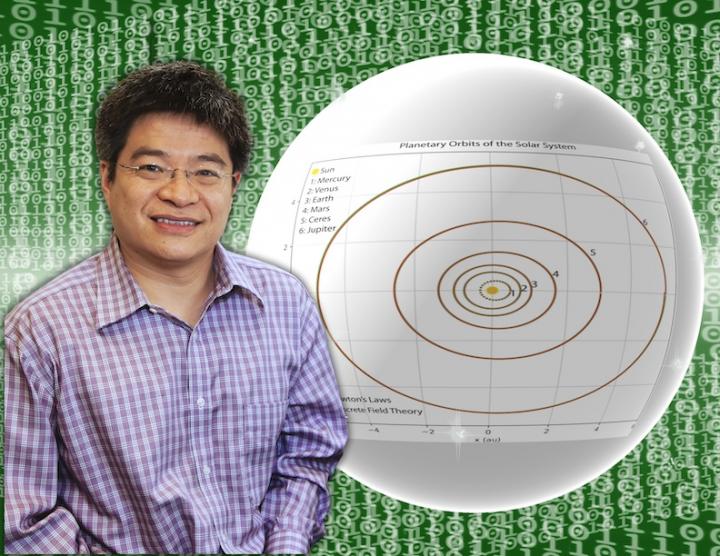
Credit: Elle Starkman / PPPL Office of Communications
A novel computer algorithm, or set of rules, that accurately predicts the orbits of planets in the solar system could be adapted to better predict and control the behavior of the plasma that fuels fusion facilities designed to harvest on Earth the fusion energy that powers the sun and stars.
The algorithm, devised by a scientist at the U.S. Department of Energy’s (DOE) Princeton Plasma Physics Laboratory (PPPL), applies machine learning, the form of artificial intelligence (AI) that learns from experience, to develop the predictions. “Usually in physics, you make observations, create a theory based on those observations, and then use that theory to predict new observations,” said PPPL physicist Hong Qin, author of a paper detailing the concept in Scientific Reports. “What I’m doing is replacing this process with a type of black box that can produce accurate predictions without using a traditional theory or law.”
Qin (pronounced Chin) created a computer program into which he fed data from past observations of the orbits of Mercury, Venus, Earth, Mars, Jupiter, and the dwarf planet Ceres. This program, along with an additional program known as a “serving algorithm,” then made accurate predictions of the orbits of other planets in the solar system without using Newton’s laws of motion and gravitation. “Essentially, I bypassed all the fundamental ingredients of physics. I go directly from data to data,” Qin said. “There is no law of physics in the middle.”
The program does not happen upon accurate predictions by accident. “Hong taught the program the underlying principle used by nature to determine the dynamics of any physical system,” said Joshua Burby, a physicist at the DOE’s Los Alamos National Laboratory who earned his Ph.D. at Princeton under Qin’s mentorship. “The payoff is that the network learns the laws of planetary motion after witnessing very few training examples. In other words, his code really ‘learns’ the laws of physics.”
Machine learning is what makes computer programs like Google Translate possible. Google Translate sifts through a vast amount of information to determine how frequently one word in one language has been translated into a word in the other language. In this way, the program can make an accurate translation without actually learning either language.
The process also appears in philosophical thought experiments like John Searle’s Chinese Room. In that scenario, a person who did not know Chinese could nevertheless “translate” a Chinese sentence into English or any other language by using a set of instructions, or rules, that would substitute for understanding. The thought experiment raises questions about what, at root, it means to understand anything at all, and whether understanding implies that something else is happening in the mind besides following rules.
Qin was inspired in part by Oxford philosopher Nick Bostrom’s philosophical thought experiment that the universe is a computer simulation. If that were true, then fundamental physical laws should reveal that the universe consists of individual chunks of space-time, like pixels in a video game. “If we live in a simulation, our world has to be discrete,” Qin said. The black box technique Qin devised does not require that physicists believe the simulation conjecture literally, though it builds on this idea to create a program that makes accurate physical predictions.
The resulting pixelated view of the world, akin to what is portrayed in the movie The Matrix, is known as a discrete field theory, which views the universe as composed of individual bits and differs from the theories that people normally create. While scientists typically devise overarching concepts of how the physical world behaves, computers just assemble a collection of data points.
Qin and Eric Palmerduca, a graduate student in the Princeton University Program in Plasma Physics, are now developing ways to use discrete field theories to predict the behavior of particles of plasma in fusion experiments conducted by scientists around the world. The most widely used fusion facilities are doughnut-shaped tokamaks that confine the plasma in powerful magnetic fields.
Fusion, the power that drives the sun and stars, combines light elements in the form of plasma — the hot, charged state of matter composed of free electrons and atomic nuclei that represents 99% of the visible universe — to generate massive amounts of energy. Scientists are seeking to replicate fusion on Earth for a virtually inexhaustible supply of power to generate electricity.
“In a magnetic fusion device, the dynamics of plasmas are complex and multi-scale, and the effective governing laws or computational models for a particular physical process that we are interested in are not always clear,” Qin said. “In these scenarios, we can apply the machine learning technique that I developed to create a discrete field theory and then apply this discrete field theory to understand and predict new experimental observations.”
This process opens up questions about the nature of science itself. Don’t scientists want to develop physics theories that explain the world, instead of simply amassing data? Aren’t theories fundamental to physics and necessary to explain and understand phenomena?
“I would argue that the ultimate goal of any scientist is prediction,” Qin said. “You might not necessarily need a law. For example, if I can perfectly predict a planetary orbit, I don’t need to know Newton’s laws of gravitation and motion. You could argue that by doing so you would understand less than if you knew Newton’s laws. In a sense, that is correct. But from a practical point of view, making accurate predictions is not doing anything less.”
Machine learning could also open up possibilities for more research. “It significantly broadens the scope of problems that you can tackle because all you need to get going is data,” Palmerduca said.
The technique could also lead to the development of a traditional physical theory. “While in some sense this method precludes the need of such a theory, it can also be viewed as a path toward one,” Palmerduca said. “When you’re trying to deduce a theory, you’d like to have as much data at your disposal as possible. If you’re given some data, you can use machine learning to fill in gaps in that data or otherwise expand the data set.”
###
Support for this research came from the DOE Office of Science (Fusion Energy Sciences).
PPPL, on Princeton University’s Forrestal Campus in Plainsboro, N.J., is devoted to creating new knowledge about the physics of plasmas — ultra-hot, charged gases — and to developing practical solutions for the creation of fusion energy. The Laboratory is managed by the University for the U.S. Department of Energy’s Office of Science, which is the single largest supporter of basic research in the physical sciences in the United States and is working to address some of the most pressing challenges of our time.
For more information, visit https:/
Media Contact
Raphael Rosen
[email protected]
Original Source
https:/
Related Journal Article
http://dx.




